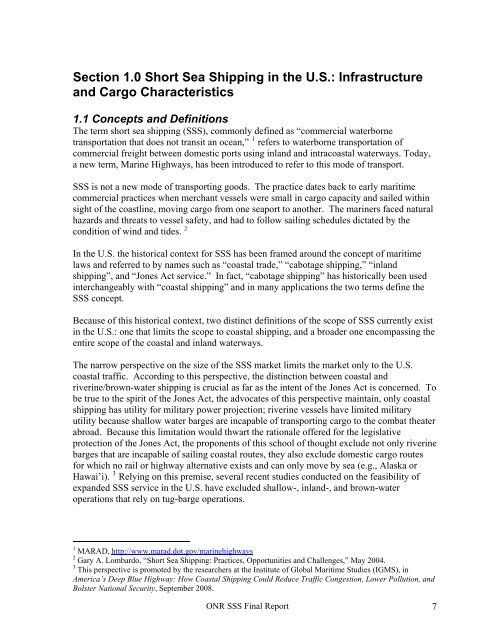Office of Naval Research - National Transportation Library
Office of Naval Research - National Transportation Library
Office of Naval Research - National Transportation Library
You also want an ePaper? Increase the reach of your titles
YUMPU automatically turns print PDFs into web optimized ePapers that Google loves.
Section 1.0 Short Sea Shipping in the U.S.: Infrastructureand Cargo Characteristics1.1 Concepts and DefinitionsThe term short sea shipping (SSS), commonly defined as “commercial waterbornetransportation that does not transit an ocean,” 1 refers to waterborne transportation <strong>of</strong>commercial freight between domestic ports using inland and intracoastal waterways. Today,a new term, Marine Highways, has been introduced to refer to this mode <strong>of</strong> transport.SSS is not a new mode <strong>of</strong> transporting goods. The practice dates back to early maritimecommercial practices when merchant vessels were small in cargo capacity and sailed withinsight <strong>of</strong> the coastline, moving cargo from one seaport to another. The mariners faced naturalhazards and threats to vessel safety, and had to follow sailing schedules dictated by thecondition <strong>of</strong> wind and tides. 2In the U.S. the historical context for SSS has been framed around the concept <strong>of</strong> maritimelaws and referred to by names such as “coastal trade,” “cabotage shipping,” “inlandshipping”, and “Jones Act service.” In fact, “cabotage shipping” has historically been usedinterchangeably with “coastal shipping” and in many applications the two terms define theSSS concept.Because <strong>of</strong> this historical context, two distinct definitions <strong>of</strong> the scope <strong>of</strong> SSS currently existin the U.S.: one that limits the scope to coastal shipping, and a broader one encompassing theentire scope <strong>of</strong> the coastal and inland waterways.The narrow perspective on the size <strong>of</strong> the SSS market limits the market only to the U.S.coastal traffic. According to this perspective, the distinction between coastal andriverine/brown-water shipping is crucial as far as the intent <strong>of</strong> the Jones Act is concerned. Tobe true to the spirit <strong>of</strong> the Jones Act, the advocates <strong>of</strong> this perspective maintain, only coastalshipping has utility for military power projection; riverine vessels have limited militaryutility because shallow water barges are incapable <strong>of</strong> transporting cargo to the combat theaterabroad. Because this limitation would thwart the rationale <strong>of</strong>fered for the legislativeprotection <strong>of</strong> the Jones Act, the proponents <strong>of</strong> this school <strong>of</strong> thought exclude not only riverinebarges that are incapable <strong>of</strong> sailing coastal routes, they also exclude domestic cargo routesfor which no rail or highway alternative exists and can only move by sea (e.g., Alaska orHawai’i). 3 Relying on this premise, several recent studies conducted on the feasibility <strong>of</strong>expanded SSS service in the U.S. have excluded shallow-, inland-, and brown-wateroperations that rely on tug-barge operations.1 MARAD, http://www.marad.dot.gov/marinehighways2 Gary A. Lombardo, “Short Sea Shipping: Practices, Opportunities and Challenges,” May 2004.3 This perspective is promoted by the researchers at the Institute <strong>of</strong> Global Maritime Studies (IGMS), inAmerica’s Deep Blue Highway: How Coastal Shipping Could Reduce Traffic Congestion, Lower Pollution, andBolster <strong>National</strong> Security, September 2008.ONR SSS Final Report 7
















